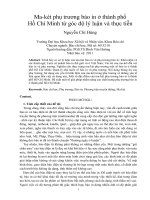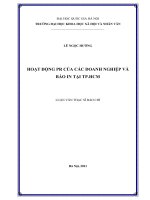Lecture note Formal methods in software engineering - Lecture 5.4 - TRƯỜNG CÁN BỘ QUẢN LÝ GIÁO DỤC THÀNH PHỐ HỒ CHÍ MINH
Bạn đang xem bản rút gọn của tài liệu. Xem và tải ngay bản đầy đủ của tài liệu tại đây (317.86 KB, 6 trang )
<span class='text_page_counter'>(1)</span><div class='page_container' data-page=1>
<i>COMSATS Virtual campus</i>
<i>Islamabad</i>
<i>Formal Methods in Software Engineering</i>
5.4.2 Semantics
Now that we have learned the basics of syntax of predicate logic, we can have a
look at the semantics. This is brought about by a relational structure M, which
realizes (or instantiates) the symbols of our language. Moreover M tells us
which formulas are valid. To start with, we have to provide some values to our
variables. The range of the values of our variables will be a nonempty set <i>M </i>,
called universe of discourse M, and its members are individuals. On this
universe of discourse, the function and predicate symbols are also realized on
this universe of discourse.
Example 5.7. The realization of the language of number theory (arithmetics, see
previous section) can be as follows: the universe of discourse is ω<i> </i>(set of all nat
ural numbers), constant 0 is realized by an empty set ∅, the successor function is
realized by a function that assigns the successive natural number to every number
<i>n </i>∈<i> </i>ω, and the function symbols + and <i>∙ </i>are realized by conventional addition
and multiplication.
Similarly to propositional calculus, we can investigate whether a certain for
mula is satisfiable or whether it is valid in every interpretation. However, in
pred icate logic, things get a bit more complicated. First, a relational structure M
real izing the language has to be chosen. This specifies how the function and
predicate symbols are realized and also gives the universe of discourse <i>M </i>, from
which we can choose the values for our variables. Once we have chosen M, we
can assign various values to our variables – an interpretation of variables in
predicate logic. An analogy to satisfiability in propositional logic would be to
find an interpreta tion of the variables for which a formula is true.
For instance, suppose we have a standard realization (also called <i>model</i>) of
number theory and the formula <i>x > y</i>. Obviously, we can find values for <i>x </i>and
<i>y </i>such that the formula is true.
</div>
<span class='text_page_counter'>(2)</span><div class='page_container' data-page=2>
from the previous example is not valid – we can easily find values for <i>x </i>and <i>y </i>
such that it is not true.
Suppose we had a formula (∀<i>x</i>)(∀<i>y</i>)<i>x > y</i>. In this case, whenever we find one
interpretation giving a value of true, we automatically know that it is valid. This
is because all free variables in the formula are universally quantified – we have
to check all possible interpretations.
Scope of a Quantifier
The definition of the scope of a quantifier is illustrated in the following example.
Example 5.8. For every human <i>x </i>there exists a human <i>y </i>that loves <i>x. </i>Stated
formally:
∀<i>x, </i>(human(<i>x</i>) →<i> </i>∃<i>y </i>(human(<i>y</i>) ∧<i> </i>loves(<i>x, y</i>)))
Definition 5.16.
!
!
scop
"
e
#
o
f x
scop
"
e
#
of y
$
$
(i) A given occurrence of a variable <i>x </i>in a formula <i>A </i>is <i>bounded</i>, if it is part of
a subformula of <i>A </i>(i.e. a substring of <i>A </i>that is also a formula) of the form
(∃<i>x</i>)<i>B </i>or (∀<i>x</i>)<i>B</i>. If an occurrence is not bounded, it is <i>free</i>.
(ii) A variable is <i>free </i>in <i>A</i>, if it has a free occurrence there.
A variable is <i>bounded </i>in <i>A</i>, if it has a bounded occurence there.
(iii) Formula <i>A </i>is <i>open</i>, if it does not contain any bounded variable.
Formula <i>A </i>is <i>closed</i>, if it does not contain any free variable.
Example 5.9. Formula <i>A</i>:
(∀<i>x</i>)(<i>x </i>→<i> y</i>)
In formula <i>A</i>, <i>x </i>has a bounded occurrence by the quantifier ∀, and hence it is
bounded in <i>A</i>, whereas <i>y </i>is not quantified and hence it has a free occurrence and
thus is free in <i>A</i>. Formula <i>A </i>is neither open nor closed.
Example 5.10. Formula <i>B</i>:
(∀<i>x</i>)(∀<i>y</i>)(<i>x </i>→<i> y</i>)
</div>
<span class='text_page_counter'>(3)</span><div class='page_container' data-page=3>
5.4.3 Formal system
For the definition of the formal system, we will use a reduced form of the language
– with logical connectives <i>¬ </i>and →<i> </i>only and with only a universal quantifier ∀.
You should be able to work out, why we can do this with the connectives. In case
of the quantifiers, we use the fact that for a formula <i>A</i>, (∃<i>x</i>)<i>A </i>is equivalent to
<i>¬</i>((∀<i>x</i>)<i>¬A</i>). The following is a formal system of predicate logic without equality.
1a) Axioms for logical connectives
(A1) – (A3) from propositional calculus
Thus, the whole propositional logic becomes a ‘subset’ of predicate logic.
Tau tologies of propositional calculus are automatically theorems of
predicate cal culus.
1b) Inference rule: Modus ponens
2) Axioms for quantifiers
2a) Specification scheme: Let <i>A </i>be a formula, <i>x </i>a variable and <i>t </i>a term that
can be substituted for <i>x </i>into <i>A</i>
(∀<i>x</i>)<i>A </i>→<i> Ax</i>[<i>t</i>]
2b) “Jump scheme:” <i>A, B </i>are formulas, <i>x </i>a variable which is not free in <i>A</i>,
then
(∀<i>x</i>)(<i>A </i>→<i> B</i>) →<i> </i>(<i>A </i>→<i> </i>(∀<i>x</i>)<i>B</i>)
Comment: This is a rather technical axiom, to be used in prenex opera
tions.
3) Inference rule: Universal generalization For an arbitrary variable <sub>formula </sub><i><sub>A</sub></i><sub>, derive (</sub> <i>x</i>, from a
∀<i>x</i>)<i>A</i>.
Comment: This shows the role of free variables in theorems. Whenever you
can prove a formula <i>A </i>with a free variable <i>x</i>, then you can prove also a
formula
</div>
<span class='text_page_counter'>(4)</span><div class='page_container' data-page=4>
Rules of Manipulation
Permutation
∀<i>x</i>(∀<i>y</i>(<i>P </i>(<i>x, y</i>))) ↔<i> </i>∀<i>y</i>(∀<i>x</i>(<i>P </i>(<i>x, y</i>)))
A similar rule can be shown for the existential quantifier.
Negation
<i>¬</i>(∀<i>x</i>(<i>P </i>(<i>x</i>))) ↔<i> </i>∃<i>x</i>(<i>¬P </i>(<i>x</i>))
For the negation of the universal quanitifer it suffices to show that there exists
one case for which <i>¬P </i>(<i>x</i>).
Nesting/Applicability
(∀<i>x </i>: <i>P </i>(<i>x</i>)) ∧<i> Q </i>↔<i> </i>∀<i>x </i>: (<i>P </i>(<i>x</i>) ∧<i> Q</i>)
Here, <i>x </i>appears in <i>P </i>, but not in <i>Q</i>. Therefore it does not affect the truth value of
<i>Q </i>when it is grouped with <i>P </i>with respect to <i>x</i>. Similar argumentation holds true
for the existential quantifier.
Prenex normal form
Just normal forms are useful for propositional calculus (conjunctive normal
form, disjunctive normal form), there is a normal form for predicate calculus.
Because of the higher complexity of predicate calculus – we have to take care of
the quan tifiers – are somewhat more involved. The goal is to move all the
quantifiers to the beginning of the formula. This makes the formulas more
transparent and compa rable, and it makes them more accessible to automated
processing.
Definition 5.17. We say that formula <i>A </i>is in <i>prenex form</i>, if it has the following
form:
where
1. <i>Qi </i>are either ∀<i> </i>or ∃
(<i>Q</i>1<i>x</i>1 ) <i>. . . </i>(<i>Qnxn</i>)<i>B</i>
2. <i>B </i>is an open formula (i.e. all variables are free in it)
3. <i>x</i>1 <i>. . . xn </i>are all different
</div>
<span class='text_page_counter'>(5)</span><div class='page_container' data-page=5>
<i>5.5. EXTENSIONS</i> 521
Replacement (renaming) of bounded variables
Suppose we have a formula <i>A </i>which contains a subformula of the form (<i>Qx</i>)<i>B</i>
(where <i>Q </i>is either ∀<i> </i>or ∃). Then it is possible to replace <i>x </i>by <i>y </i>(in the prefix as
well as in the formula <i>B</i>) and we obtain an equivalent formula <i>A!</i><sub>, a variation of</sub>
<i>A</i>. However, we have to take care – the original formula <i>B </i>could not contain
free occurences of <i>y </i>as these would then become bounded by our replacement.
The safest way is to take a completely new symbol to name our variable.
Theorem 5.3. <i>For every formula A, it is possible to construct an equivalent for </i>
<i>mula A! <sub>in prenex form, such that ( A </sub></i><sub>↔</sub><i><sub> A</sub>!<sub>.</sub></i>
<i>Proof. </i>Formula <i>A! </i><sub>is constructed by using prenex operations. These replace sub </sub>
formulas of <i>A </i>according to one of the following schemes (where <i>Q </i>is either ∀<i> </i>or
∃<i> </i>and <i>Q</i>ˉ is the other quantifier than <i>Q</i>).
(a) replace subformula <i>B </i>by a variation of it <i>B!</i>
(b) replace subformula <i>¬</i>(<i>Qx</i>)<i>B </i> by
(<i>Q</i>ˉ<i>x</i>)<i>¬B</i>
(c) if <i>x </i>is not free in <i>B</i>, replace subformula <i>B </i>→<i> </i>(<i>Qx</i>)<i>C </i>by (<i>Qx</i>)(<i>B </i>→<i> C </i>)
(d) if <i>x </i>is not free in <i>C </i>, replace subformula (<i>Qx</i>)<i>B </i>→<i> C </i>by (<i>Q</i>ˉ<i>x</i>)(<i>B </i>→<i> C </i>
)
(e) if the symbol <i>" </i>represents either ∧<i> </i>or ∨<i> </i>and <i>x </i>is not free in <i>C </i>, then replace
the subformula
(<i>Qx</i>)<i>B " C </i> or <i>C " </i>(<i>Qx</i>)<i>B</i> by (<i>Qx</i>)(<i>B " C </i>)
5.5 Extensions
</div>
<span class='text_page_counter'>(6)</span><div class='page_container' data-page=6></div>
<!--links-->









